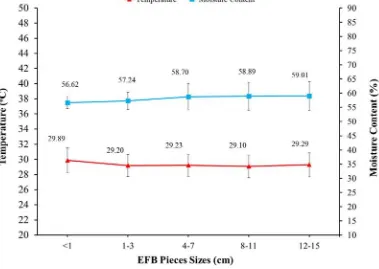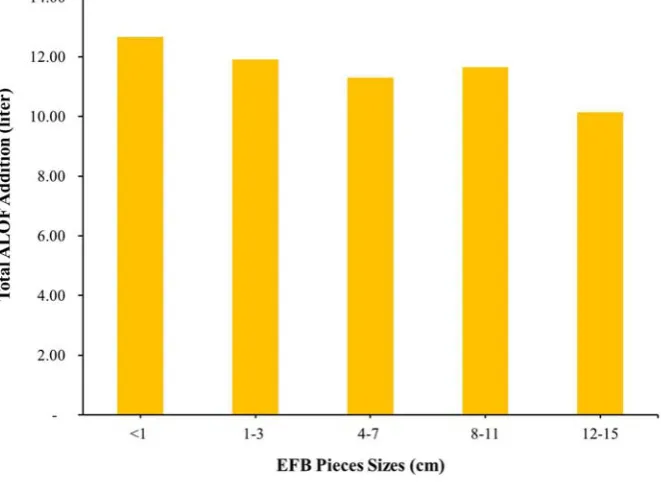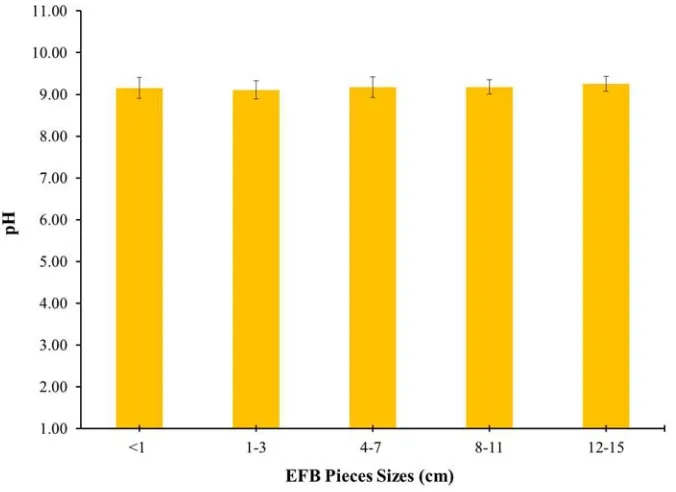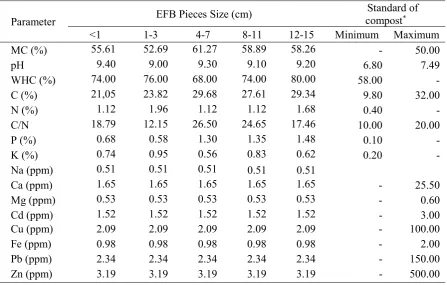IOP Conference Series: Materials Science and Engineering
PAPER • OPEN ACCESS
Effect of pieces size of Empty Fruit Bunches (EFB)
on composting of EFB mixed with activated liquid
organic fertilizer
To cite this article: B Trisakti et al 2018 IOP Conf. Ser.: Mater. Sci. Eng.309 012093
View the article online for updates and enhancements.
Related content
Effect of Turning Frequency on
Composting of Empty Fruit Bunches Mixed with Activated Liquid Organic Fertilizer
B Trisakti, J Lubis, T Husaini et al.
-Composting of empty fruit bunches in the tower composter – effect of air intake holes
Irvan, T Husaini, B Trisakti et al.
-Electricity generation from palm oil tree empty fruit bunch (EFB) using dual chamber microbial fuel cell (MFC)
N F Ghazali, N A B N Mahmood, K A Ibrahim et al.
1234567890‘’“”
TALENTA-CEST 2017 IOP Publishing
IOP Conf. Series: Materials Science and Engineering 309 (2018) 012093 doi:10.1088/1757-899X/309/1/012093
Effect of pieces size of Empty Fruit Bunches (EFB) on
composting of EFB mixed with activated liquid organic
fertilizer
B Trisakti*1,2, P Mhardela1, T Husaini1, Irvan1,2, and H Daimon3
1Chemical Engineering Department, Faculty of Engineering, Universitas Sumatera
Utara. Jalan Almamater Komplek USU Medan, 20155, Indonesia
2Sustainable Energy and Biomaterial Center of Excellence, Universitas Sumatera
Utara, Medan, 20155, Indonesia
3Department of Environmental and Life Sciences, Toyohashi University of
Technology, Toyohashi, 441-8580, Japan
*Email: [email protected]
Abstract. This research was to determine the effect of pieces sizes of oil palm empty fruit bunch (EFB) on the composting of EFB mixed with activated liquid organic fertilizer (ALOF) in a basket composter in order to obtain high quality compost. The composting process was started by cutting the EFB into pieces with varies sizes, inserting the EFB pieces into basket composter (33 cm W × 28 cm L × 40 cm H), and adding ALOF until moisture content (MC) in the range of 55-65%. During composting, the compost pile was turned every 3 days and the MC was maintained at 55-65% range by adding the ALOF. The sizes of the EFB pieces were varied into <1, 1-3, 4-7, 8-11, and 12-15 cm. The parameters analysed during the composting were temperature, pH, MC, compost weight, water holding capacity (WHC), CN ratio, and the quality of the final compost. Composting was carried out for 40 days and the best result obtained at EFB pieces size was 1-3 cm with compost characteristic were pH 9.0; MC 52.59%; WHC 76%; CN ratio 12.15; N 1.96%; P 0.58%; and K 0. 95%.
1. Introduction
Oil palm plantations have become the most important economic contributor in Indonesia. However, in the processing of fresh fruit bunches (FFB) at palm oil mill (POM), besides producing palm oil and palm kernel, also produced by-product of liquid and solid waste. For every ton of treated FFB will be produced about 0.6 to 0.87 m3 of liquid waste (or 2.4 to 3.7 tons of liquid waste per tonne of palm oil produced)
[1] with biological oxygen demand (BOD) 20,000-25,000 mg/L, chemical oxygen demand (COD) of 40,000-50,000 mg/L, and pH 3.8 to 4.5 [2,3]. In addition, for every ton of TBS processed, POM also generates large amounts of solids wastes such as empty fruit bunch (EFB) (23%), shell (5%), and mesocarp fiber (12%) [4,5].
Before 1996, EFB was burned in an incinerator to ashes. The ash of EFB can be used as fertilizer, because its potassium content is relatively high ± 30%. However, to prevent air pollution, the EFB combustion process is prohibited through Minister of Environment Decree number 15 of 1996 on the blue-sky program [6].
2
1234567890‘’“”
TALENTA-CEST 2017 IOP Publishing
IOP Conf. Series: Materials Science and Engineering 309 (2018) 012093 doi:10.1088/1757-899X/309/1/012093
but its utilization is costly for labor and transportation [7]. Moreover, the processes of composting of mulch take a long time depending on environmental factors. Therefore, EFB should be composted before being spread to the field, or distributed to the farmers. Compost will also become potential products when used for the cultivation of ornamental plants [6].
Composting is a means to change various organic wastes into products that can be used safely and profitably as a biological fertilizer. The main function of the compost is to help improve the physical, chemical and biological of soil. Physically, compost can loosen the soil, compost application into the soil increase the number of cavities so that the soil becomes loose. While chemical properties capable addressed by the application of compost is increasing the cation exchange capacity (CEC) of the soil and can increase the ability of soil to water retain (water holding capacity). As for the improvement of biological characteristics, the compost can improve soil microorganism populations [8]. The composting process are influenced by number of factors such as nutrients, CN ratio, size of the compost material, temperature, pH, water content, and turning frequency [6,9].
Several studies have been conducted to process EFB into compost by mixing it with additional materials such as manure [10] or palm oil mill effluent (POME) [11]. This research used activated liquid organic fertilizer (ALOF) as alternative additional materials as it is also used by Trisakti et al [6]. ALOF is product of advance fermentation of treated biogas effluent from methanogenic anaerobic digester, which still has high nutritional and microbial sources. Hence, mixing EFB with ALOF in the basket composter might enrich the compost material with high nutrient and microbial sources [6]. Therefore, the aim of this research is to determine the effect of EFB pieces sizes on the rate of composting of EFB mixed with ALOF in a basket composter.
2. Materials and Methods
2.1. Materials
Main materials in this research were EFB and ALOF. EFBs were obtained from Rambutan POM, Sumatera Utara, Indonesia. The EFB was shredded and cut to varied size of <1, 1-3, 4-7, 8-11, and 12-15 cm. While, ALOF were liquid product from methanogenic anaerobic digestion obtained from USU - Biogas Pilot Plant, Pusdiklat LPPM, USU, Medan, Indonesia. Characteristics of EFB and ALOF are presented in Table 1.
Table 1. Characteristic of EFB and ALOF
Parameters Unit EFB ALOF
Moisture (%) 43.83 -
1234567890‘’“”
TALENTA-CEST 2017 IOP Publishing
IOP Conf. Series: Materials Science and Engineering 309 (2018) 012093 doi:10.1088/1757-899X/309/1/012093
2.3. Composting Process
Composting process was started by shredding and cutting EFB to size of The EFB was shredded and cut to varied size of <1, 1-3, 4-7, 8-11 and 12-15 cm, measuring the weight of total EFB, and putting into the composter. Next, ALOF was poured and mixed until the moisture content of compost reached 55-65% and maintained at that value range during the composting proceed. During the process, compost pile was turned every three days in order to reduce and equalize the moisture content.
2.4. Sampling and Data Collection
Sampling was carried out by collecting approximately 20 g of composting materials through sampling holes. Meanwhile, temperature measurement was performed by inserting digital thermometer through thermometer holes. Data collected during the experiment were temperature, moisture content (MC), pH, CN ratio, and compost quality. Temperature measurement was performed twice a day, in the morning and afternoon. Moisture content was determined everyday by drying oven method. pH was measured every two days. Content of C and N were determined on days 0th, 40th, and 60th, by Walkley & Black and Kjeldahl methods.
3. Results and Discussions
The composting process of EFB from palm oil mill was carried out by shredding and cutting EFB to varied size of <1, 1-3, 4-7, 8-11, and 12-15 cm and then mixing with ALOF. Composting process was conducted in the basket composter with turning frequency three days. Composting process was evaluated for 60 days by measuring and determining the temperature, moisture content (MC), pH, CN ratio, and others compost quality. The results of the research are described in this following section.
3.1. Effect of EFB Pieces Size on Temperature and Moisture Content
Temperature and moisture content are the most important parameter to be measured in the composting process [12]. The average of temperature and moisture content during the composting process that EFB pieces sizes of <1, 1-3, 4-7, 8-11, and 12-15 cm was presented in Figure 1.
4
1234567890‘’“”
TALENTA-CEST 2017 IOP Publishing
IOP Conf. Series: Materials Science and Engineering 309 (2018) 012093 doi:10.1088/1757-899X/309/1/012093
Figure 1 shows that the average temperature in composting of EFB pieces sizes of <1, 1-3, 4-7, 8-11, and 12-15 cm were 29.89 ± 1.63, 29.20 ± 1.46, 29.23 ± 1.47, 29.10 ± 1.49, and 29.29 ± 1.59°C, respectively. This means, an increase in the size of EFB pieces (compost material) cause to lower composting temperatures and the highest average temperature achieved at composting EFB with size <1 cm. This is consistent with the statement of Bueno et al., that the highest temperature is achieved at the smallest compost size [13]. This is due to the small particle size making porosity between small materials and not providing air space between particles [14], so heat will increase in the stack [15]. The error bar at temperature curve shows the temperature difference at each part of compost material pile, because the activity of microorganisms in each section height of compost material pile is different [16].
Figure 1 also shows that the average MC in composting of EFB pieces sizes of <1, 1-3, 4-7, 8-11, and 12-15 cm were 56.62 ± 3.05, 57.24 ± 3.05, 58.70 ± 4.68, 58.89 ± 4.91, and 59.01 ± 5.10%, respectively. The value of average MC increased with the increasing of EFB pieces size but the values are in the range of 56.62 - 59.01% or still in the range of best MC value for composting [4,17]. Baharuddin et al. [4] reported that the best of MC value for composting is in the range of 55-65%. If the MC value is too high, it can inhibit the growth of microorganisms because water molecules are going to fill the air cavity resulting in anaerobic conditions, which will cause odor and can kill aerobic microorganisms due to oxygen deficiency [16,18].
3.2. Effect of EFB Pieces Size on ALOF Addition
ALOF addition in each composter depends on the MC value of compost pile. It is maintained in the range of 55-65%. Therefore, at the end of composting, the total number of ALOF added to each composter is different. The number of ALOF added to each composter containing the sized EFB pieces <1, 1-3, 4-7, 8-11, and 12-15 cm is presented in Figure 2.
Figure 2 shows that the total addition of ALOF in composting of EFB pieces sizes of <1, 1-3, 4-7, 8-11, and 12-15 cm were 12.66, 11.91, 11.3, 11.65 and 10.14 liters, respectively. The biggest ALOF addition is compost with EFB pieces size <1 cm and the smallest is compost with EFB pieces size 12-15 cm. However, the difference is relatively small due to the average of ALOF addition was 11.53 ± 0.92 liters.
1234567890‘’“”
TALENTA-CEST 2017 IOP Publishing
IOP Conf. Series: Materials Science and Engineering 309 (2018) 012093 doi:10.1088/1757-899X/309/1/012093
3.3. Effect of EFB Pieces Size on Compost pH
The average value of compost pH during the composting process of EFB pieces sizes of <1, 1-3, 4-7, 8-11, and 12-15 cm is presented in Figure 3.
Figure 3. Effect of EFB pieces size on compost pH
Figure 3 shows that the average value of compost pH in composting of EFB pieces sizes of <1, 1-3, 4-7, 8-11, and 12-15 cm were 9.15 ± 0.25, 9.11 ± 0.22, 9.17 ± 0.25, 9.18 ± 0.17, and 9.25 ± 0.18%, respectively. The highest average value of compost pH is compost with EFB pieces size 12-15 cm and tends to fall with decreasing of EFB pieces size, but the lowest pH value is compost with EFB pieces size 1-3 cm.
The pH value of the compost tend to base condition and this is good because it can inhibit the growth of pathogens such as fungi that can survive in acidic conditions [19]. The base condition occur because, if the size of the compost material increases than more N elements will decrease [17]. Reducing N in composting occurs because N turn to NH3 or NH4+ by the ammonification process, so the pH increases
[20].
3.4. Effect of EFB Pieces Size on CN Ratio
Maturity and quality of the compost produced is determined by analyzing the compost based on the CN ratio. The CN ratio of the compost material at 0th, 40th, and 60th day of compost with EFB pieces sizes of <1, 1-3, 4-7, 8-11, and 12-15 cm is presented in Figure 4.
Figure 4 shows that the initial CN ratio of composting material at each EFB pieces sizes variation is the same, i.e. 33.48. On the 40th day, the CN ratio of the compost drastically decreased, where the CN ratio of compost with EFB pieces sizes of <1, 1-3, 4-7, 8-11, and 12-15 cm were 18.79, 12.15, 26.50, 24.65, and 17.46, respectively. Finally, on the 60th day, the CN ratio of compost with EFB pieces sizes of <1, 1-3, 4-7, 8-11, and 12-15 cm were 10.00, 11.74, 13.48, 16.07, and 12.11, respectively. The CN ratio decreases is occurs because of the organic matter decomposition as the results of microbial activity [17,21]. On 60th day, C-N ratio for each EFB pieces size variation is below 20, it means the compost is
6
1234567890‘’“”
TALENTA-CEST 2017 IOP Publishing
IOP Conf. Series: Materials Science and Engineering 309 (2018) 012093 doi:10.1088/1757-899X/309/1/012093
ratio is still above 20. Results of complete analysis of compost quality and standard of compost are presented in Table 2.
Figure 4. Effect of EFB pieces size on CN ratio
Table 2. Results of complete analysis of compost quality and standard of compost
Parameter EFB Pieces Size (cm)
Standard of compost*
<1 1-3 4-7 8-11 12-15 Minimum Maximum
MC (%) 55.61 52.69 61.27 58.89 58.26 - 50.00
pH 9.40 9.00 9.30 9.10 9.20 6.80 7.49
WHC (%) 74.00 76.00 68.00 74.00 80.00 58.00 - C (%) 21,05 23.82 29.68 27.61 29.34 9.80 32.00
N (%) 1.12 1.96 1.12 1.12 1.68 0.40 -
C/N 18.79 12.15 26.50 24.65 17.46 10.00 20.00
P (%) 0.68 0.58 1.30 1.35 1.48 0.10 -
K (%) 0.74 0.95 0.56 0.83 0.62 0.20 -
Na (ppm) 0.51 0.51 0.51 0.51 0.51
Ca (ppm) 1.65 1.65 1.65 1.65 1.65 - 25.50
Mg (ppm) 0.53 0.53 0.53 0.53 0.53 - 0.60
Cd (ppm) 1.52 1.52 1.52 1.52 1.52 - 3.00
Cu (ppm) 2.09 2.09 2.09 2.09 2.09 - 100.00
Fe (ppm) 0.98 0.98 0.98 0.98 0.98 - 2.00
1234567890‘’“”
TALENTA-CEST 2017 IOP Publishing
IOP Conf. Series: Materials Science and Engineering 309 (2018) 012093 doi:10.1088/1757-899X/309/1/012093
It can be said that the value of the CN ratio decreases with the smallness of the EFB pieces size. This is because the smaller particle size will cause the surface area of the particle to be large, so the decomposition process becomes faster [14]. However, there is an aberration that the smallest CN ratio value is generated by the EFB pieces size of a 1-3 cm. This is because the EFB pieces size of a 1-3 cm is in accordance with the basket composter used.
Conclusions
Composting of oil palm empty fruit bunches (EFB) mixed with activated liquid organic fertilizer (ALOF) was carried out for 40 days and the best result obtained at EFB pieces size was 1-3 cm with compost characteristic were pH 9.0; MC 52.59%; WHC 76%; CN ratio 12.15; N 1.96%; P 0.58%; and K 0. 95%.
Acknowledgments
This research was financially supported by Lembaga Penelitian Universitas Sumatera Utara in accordance with the research contract TALENTA Universitas Sumatera Utara fiscal year 2017 number: 5338/UN5.1.R/PPM/2017, date May 22, 2017.
References
[1] Trisakti B, Irvan, Mahdalena, Taslim and Turmuzi M 2017 Effect of temperature on methanogenesis stage of two-stage anaerobic digestion of palm oil mill effluent (POME) into biogas IOP Conf. Ser. Mater. Sci. Eng.206 8
[2] Irvan, Trisakti B, Sosanty F and Tomiuchi Y 2016 Effect of Discontinuing Sodium Bicarbonate on Fermentation Process of Palm Oil Mill Effluent Asian J. Chem.28 377–80
[3] Trisakti B, Irvan, Zahara I, Taslim and Turmuzi M 2017 Effect of agitation on methanogenesis stage of two-stage anaerobic digestion of palm oil mill effluent (POME) into biogas AIP Conf. Proc.1840 7
[4] Baharuddin A S, Hock L S, Yusof M Z, Abdul N A, Shah U, Hassan M A, Wakisaka M, Sakai K and Shirai Y 2010 The effect of palm oil mill effluent (POME) anaerobic sludge from 500 m3 of
closed anaerobic methane digested tank on pressed-shredded empty fruit bunch (EFB) composting process African J. …9 2427–36
[5] Trisakti B, Manalu V, Irvan, Taslim and Turmuzi M 2015 Acidogenesis of Palm Oil Mill Effluent to Produce Biogas: Effect of Hydraulic Retention Time and pH Procedia - Soc. Behav. Sci.195
2466–74
[6] Trisakti B, Lubis J, Husaini T and Irvan 2017 Effect of Turning Frequency on Composting of Empty Fruit Bunches Mixed with Activated Liquid Organic Fertilizer IOP Conf. Ser. Mater. Sci. Eng.180 8
[7] Kavitha B, Jothimani P and Rajannan G 2013 Empty Fruit Bunch-a Potential Organic Manure for Agriculture Int. J. Sci. Environ. Technol.2 930–7
[8] Oviasogie P O, Aisueni N O and Brown G E 2010 Oil palm composted biomass: A review of the preparation, utilization, handling and storage African J. Agric. Res.5 1553–71
[9] Tchobanoglous G, Theisen H and Vigil S A 1993 Integrated Solid Waste Management: Engineering Principles and Management Issues (McGraw-Hill Education)
[10] Suhaimi M and Ong H K 2001 Composting Empty Fruit Bunches of Oil Palm Ext. Bull. - Food Fertil. Technol. Cent.505 1–8
[11] Baharuddin A S, Wakisaka M, Shirai Y, Abd-Aziz S, Abdul Rahman N A and Hassan M A 2009 Co composting of Empty Fruit Bunches and Partially Treated Palm Oil Mill Effluents in Pilot Scale Int. J. Agric. Res.4 69–78
8
1234567890‘’“”
TALENTA-CEST 2017 IOP Publishing
IOP Conf. Series: Materials Science and Engineering 309 (2018) 012093 doi:10.1088/1757-899X/309/1/012093
and The 4th National Congress on Recycling of Organic Waste in Agricultural (Isfahan, Iran) pp 1–9
[13] Bueno P, Tapias R, López F and Díaz M J 2008 Optimizing composting parameters for nitrogen conservation in composting Bioresour. Technol.99 5069–77
[14] Rynk R, Van de Kamp M, Willson G B, Singley M E, Richard T L, Kolega J J, Gouin F R, Laliberty, Jr. L, Kay D, Murphy D W, Hoitink H A J and Brinton W F 1992 Optimizing Composting Parameter for Nitrogen Conservation in Composting ed R Rynk (New York: Northeast Regional Agricultural Engineering Service)
[15] Mortazavi M, Ghehsareh A M and Kalbasi M 2012 The Effect of Particle Size and Composting Period on (C/N) Ratio of Date- Palm Waste The 1st International and the 4th National Congress on Recycling of Organic Waste in Agriculture (Isfahan, Iran) pp 1–5
[16] Tiquia S M, Tam N F Y and Hodgkiss I J 1997 Effects of turning frequency on composting of spent pig-manure sawdust litter Bioresour. Technol.62 37–42
[17] Wan Razali W A, Baharuddin A S, TarmezeeTalib A, Sulaiman A, Naim M N, Hassan M A and Shirai Y 2012 Degradation of oil palm empty fruit bunches (OPEFB) fibre during composting process using in-vessel composter BioResources7 4786–805
[18] Shen Y, Ren L, Li G, Chen T and Guo R 2011 Influence of aeration on CH4, N2O and NH3
emissions during aerobic composting of a chicken manure and high C/N waste mixture Waste Manag.31 33–8
[19] Saidi N, Chérif M, Jedidi N, Mahrouk M, Fumio M, Boudabous A, Hassen A, P T R B and Lif H 2008 Evolution of Biochemical Parameters during Composting of Various Wastes Compost Am. J. Environ. Sci.4 332–41
[20] Kananam W, Suksaroj T T and Suksaroj C 2011 Biochemical changes during oil palm (Elaeis guineensis) empty fruit bunches composting with decanter sludge and chicken manure
ScienceAsia37 17–23
[21] Hock L, Baharuddin A S, Ahmad M N, Shah U K M, Rahman N a. a., Abd-Aziz S, Hassan M a. and Shirai Y 2009 Physicochemical changes in windrow co-composting process of oil palm mesocarp fiber and palm oil mill effluent anaerobic sludge. Aust. J. Basic Appl. Sci.3 2809–16 [22] Zahrim A Y and Asis Tahang 2010 Production of Non Shredded Empty Fruit Bunch




